新概念英语第二册:第30课课文详解及语法解析.doc
- 格式:doc
- 大小:91.00 KB
- 文档页数:6

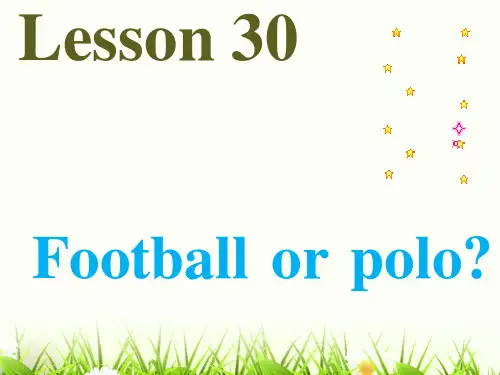
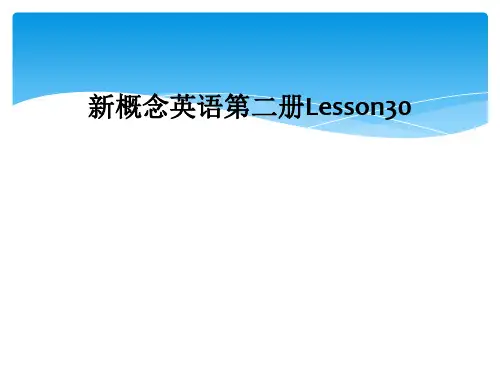
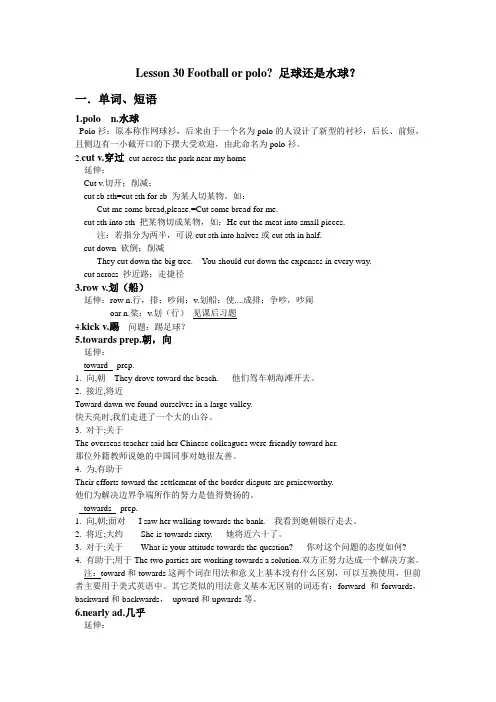
Lesson 30 Football or polo? 足球还是水球?一.单词、短语1.polo n.水球Polo衫:原本称作网球衫,后来由于一个名为polo的人设计了新型的衬衫,后长、前短,且侧边有一小截开口的下摆大受欢迎,由此命名为polo衫。
2.cut v.穿过cut across the park near my home延伸:Cut v.切开;削减;cut sb sth=cut sth for sb 为某人切某物。
如:Cut me some bread,please.=Cut some bread for me.cut sth into sth 把某物切成某物,如:He cut the meat into small pieces.注:若指分为两半,可说cut sth into halves或cut sth in half.cut down 砍倒;削减They cut down the big tree. You should cut down the expenses in every way.cut across 抄近路;走捷径3.row v.划(船)延伸:row n.行,排;吵闹;v.划船:使....成排;争吵,吵闹oar n.桨;v.划(行)见课后习题4.kick v.踢问题:踢足球?5.towards prep.朝,向延伸:toward prep.1. 向,朝They drove toward the beach. 他们驾车朝海滩开去。
2. 接近,将近Toward dawn we found ourselves in a large valley.快天亮时,我们走进了一个大的山谷。
3. 对于;关于The overseas teacher said her Chinese colleagues were friendly toward her.那位外籍教师说她的中国同事对她很友善。
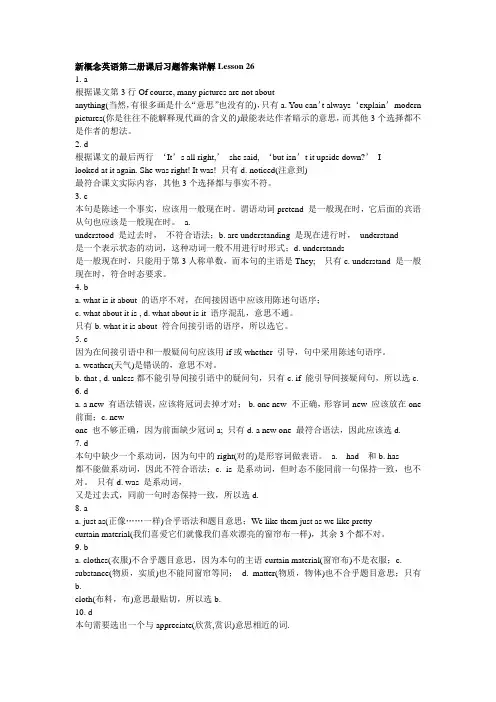
新概念英语第二册课后习题答案详解Lesson 261. a根据课文第3行Of course, many pictures are not aboutanything(当然,有很多画是什么“意思”也没有的),只有a. You can’t always ‘explain’modern pictures(你是往往不能解释现代画的含义的)最能表达作者暗示的意思,而其他3个选择都不是作者的想法。
2. d根据课文的最后两行‘It’s all right,’she said, ‘but isn’t it upside down?’Ilooked at it again. She was right! It was! 只有d. noticed(注意到)最符合课文实际内容,其他3个选择都与事实不符。
3. c本句是陈述一个事实,应该用一般现在时。
谓语动词pretend 是一般现在时,它后面的宾语从句也应该是一般现在时。
a.understood 是过去时,不符合语法;b. are understanding 是现在进行时,understand是一个表示状态的动词,这种动词一般不用进行时形式;d. understands是一般现在时,只能用于第3人称单数,而本句的主语是They; 只有c. understand 是一般现在时,符合时态要求。
4. ba. what is it about 的语序不对,在间接因语中应该用陈述句语序;c. what about it is ,d. what about is it 语序混乱,意思不通。
只有b. what it is about 符合间接引语的语序,所以选它。
5. c因为在间接引语中和一般疑问句应该用if或whether 引导,句中采用陈述句语序。
a. weather(天气)是错误的,意思不对。
b. that , d. unless都不能引导间接引语中的疑问句,只有c. if 能引导间接疑问句,所以选c.6. da. a new 有语法错误,应该将冠词去掉才对;b. one new 不正确,形容词new 应该放在one 前面;c. newone 也不够正确,因为前面缺少冠词a; 只有d. a new one 最符合语法,因此应该选d.7. d本句中缺少一个系动词,因为句中的right(对的)是形容词做表语。

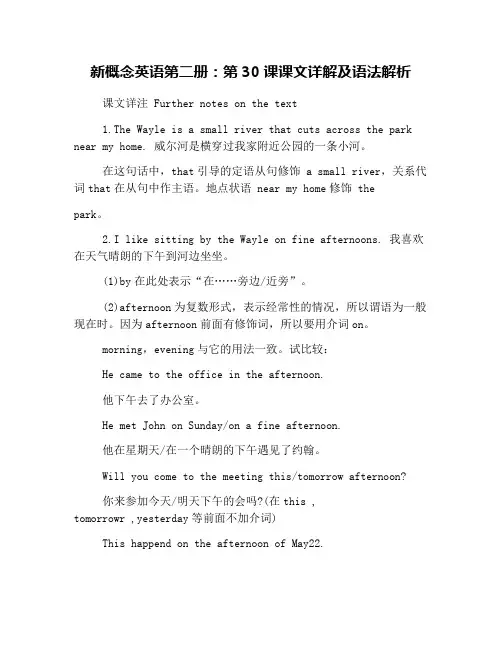
新概念英语第二册:第30课课文详解及语法解析课文详注 Further notes on the text1.The Wayle is a small river that cuts across the park near my home. 威尔河是横穿过我家附近公园的一条小河。
在这句话中,that引导的定语从句修饰 a small river,关系代词that在从句中作主语。
地点状语 near my home修饰 thepark。
2.I like sitting by the Wayle on fine afternoons. 我喜欢在天气晴朗的下午到河边坐坐。
(1)by在此处表示“在……旁边/近旁”。
(2)afternoon为复数形式,表示经常性的情况,所以谓语为一般现在时。
因为afternoon前面有修饰词,所以要用介词on。
morning,evening与它的用法一致。
试比较:He came to the office in the afternoon.他下午去了办公室。
He met John on Sunday/on a fine afternoon.他在星期天/在一个晴朗的下午遇见了约翰。
Will you come to the meeting this/tomorrow afternoon?你来参加今天/明天下午的会吗?(在this ,tomorrowr ,yesterday等前面不加介词)This happend on the afternoon of May22.这事发生于5月22日下午。
(请注意在the afternoon of May22之前要用介词on)3.…it went towards a passing boat.……球便向着一只划过来的小船飞去。
(1)go在此处不是指人“走”,而是指球“行进”。
(2)passing为现在分词,作定语,表示“经过的”、“划过来的”,如a passing plane(一架飞过的飞机)。

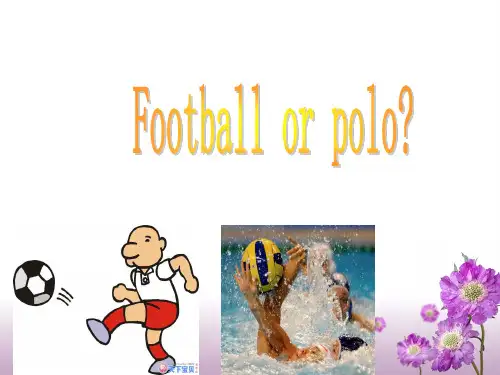
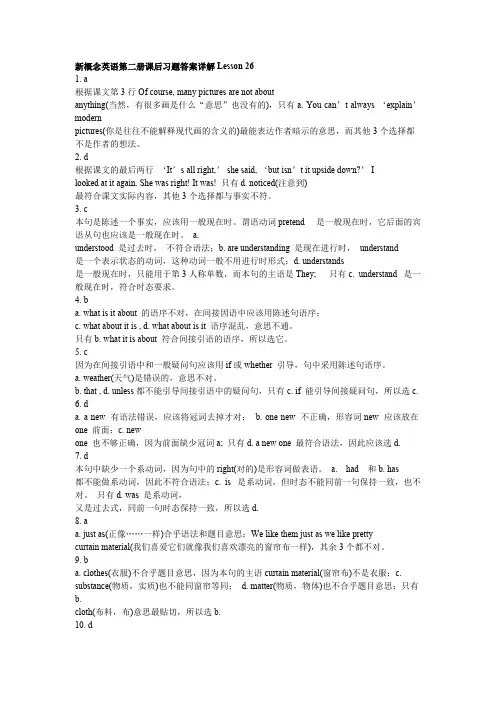
新概念英语第二册课后习题答案详解Lesson 261. a根据课文第3行Of course, many pictures are not aboutanything(当然,有很多画是什么“意思”也没有的),只有a. You can’t always ‘explain’modernpictures(你是往往不能解释现代画的含义的)最能表达作者暗示的意思,而其他3个选择都不是作者的想法。
2. d根据课文的最后两行‘It’s all right,’ she said, ‘but isn’t it upside down?’ Ilooked at it again. She was right! It was! 只有d. noticed(注意到)最符合课文实际内容,其他3个选择都与事实不符。
3. c本句是陈述一个事实,应该用一般现在时。
谓语动词pretend 是一般现在时,它后面的宾语从句也应该是一般现在时。
a.understood 是过去时,不符合语法;b. are understanding 是现在进行时,understand是一个表示状态的动词,这种动词一般不用进行时形式;d. understands是一般现在时,只能用于第3人称单数,而本句的主语是They; 只有c. understand 是一般现在时,符合时态要求。
4. ba. what is it about 的语序不对,在间接因语中应该用陈述句语序;c. what about it is ,d. what about is it 语序混乱,意思不通。
只有b. what it is about 符合间接引语的语序,所以选它。
5. c因为在间接引语中和一般疑问句应该用if或whether 引导,句中采用陈述句语序。
a. weather(天气)是错误的,意思不对。
b. that , d. unless都不能引导间接引语中的疑问句,只有c. if 能引导间接疑问句,所以选c.6. da. a new 有语法错误,应该将冠词去掉才对;b. one new 不正确,形容词new 应该放在one 前面;c. newone 也不够正确,因为前面缺少冠词a; 只有d. a new one 最符合语法,因此应该选d.7. d本句中缺少一个系动词,因为句中的right(对的)是形容词做表语。
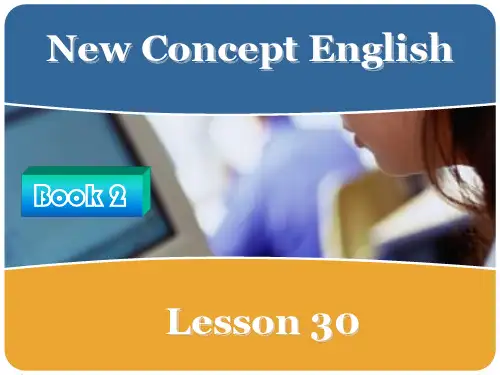
新概念英语第二册课后练习题答案详解( 第 30 课)新概念英语第二册课后习题Lesson 301. a根据课文第 2 行 I like sitting by the Wayle on fineafternoons, 只有 a. likes sitting on the bank of the riverwhen it ’s fine 最符合课文的实际情况,其他 3 个选择都不是课文所提及的情况。
2. a根据课文第 6-7 行 Some people on the bank called out tothe man in the boat, but he did not hear them能够看出,只有a. some people tried to warn the man about the ball(一些人设法提醒这个人注意球 ) 是真实的,其他 3 个选择都与课文的实际内容不符。
3. d在河流的名字前面应该加定冠词 , 本句中的 Wayle 是河流的名字 , 所以只有 d. the Wayle 最准确 , 而其他 3 个选择都不对 .4. a前一句中的介词 across 是“横越”“从一边到另一边”的意思,要选出同它意思相近的词,才能同前面句子意义相同。
b. over( 越过 ) ,c. round( 环绕,绕过 ) 与d. along( 沿着) 这 3 个词都不够恰当,只有 a. through( 穿过,从一边进另一边出 ) 同 across 含义相同5. b只有 b. hard(用力地)符合题目意思.a. hardly(几乎不)不符合题目意思.c. hardy(壮的)意思不,是形容,不能修.d. hardily是副,有"大胆地,毅地"意思.6. c只有 c. in the direction(朝着⋯⋯的方向)才能同前一句The ball went towards a passing boat(球向着一只划来的船去) 的意思相符。
新概念英语第二册:第30课课文详解及语法解析课文详注 Further notes on the text
1.The Wayle is a small river that cuts across the park near my home. 威尔河是横穿过我家附近公园的一条小河。
在这句话中,that引导的定语从句修饰 a small river,关系代词that在从句中作主语。
地点状语 near my home修饰 the
park。
2.I like sitting by the Wayle on fine afternoons. 我喜欢在天气晴朗的下午到河边坐坐。
(1)by在此处表示“在……旁边/近旁”。
(2)afternoon为复数形式,表示经常性的情况,所以谓语为一般现在时。
因为afternoon前面有修饰词,所以要用介词on。
morning,evening与它的用法一致。
试比较:
He came to the office in the afternoon.
他下午去了办公室。
He met John on Sunday/on a fine afternoon.
他在星期天/在一个晴朗的下午遇见了约翰。
Will you come to the meeting this/tomorrow afternoon?
你来参加今天/明天下午的会吗?(在this ,
tomorrowr ,yesterday等前面不加介词)
This happend on the afternoon of May22.
这事发生于5月22日下午。
(请注意在the afternoon of May22之前要用介词on)
3.…it went towards a passing boat.……球便向着一只划过来的小船飞去。
(1)go在此处不是指人“走”,而是指球“行进”。
(2)passing为现在分词,作定语,表示“经过的”、“划过来的”,如a passing plane(一架飞过的飞机)。
4.Some people on the bank called out to the man in the boat…岸上的一些人对着小船上的人高喊……
call out表示“大声呼叫”、“叫喊”,比call语气要重:
I heard someone calling out for help.
我听到有人在大声呼救。
Mary called out to her father, but he was too far away and couldn't hear her.
玛丽对着她的父亲高喊,但他离得太远了,听不到她的喊叫。
5.The ball struck him so hard that he nearly fell into the water.
球重重地打在他身上,使他差点儿落入水中。
so +形容词+that通常引导结果状语从句,表示“如此……以至于……”:
The book was so interesting that I read it in two hours.
这本书如此有趣,我两个小时就把它看完了。
The box is so heavy that I can't lift it without your help.
这箱子太重了,以至于没有你的协助我无法把它举起来。
这个结构也能够用于so +副词+that从句结构:
He ran so quickly that no one could catch up with him.
他跑得非常快,没人能赶上他。
It rained so hard that we couldn't go out.
雨下得很大,我们无法出去。
在口语中,引导词that往往能够省略。
6.I turned to look at the children, but there weren't any in sight…我转过头去看那些孩子,但一个也不见……
(1)any代替 any children。
(2) in sight表示“看得见”、“在视野之内”,反义词为 out of sight:
No bus is in sight.
看不见任何公共汽车。
Mary came in sight when I was waiting for Lucy.
我等露西的时候,玛丽出现了。
In the afternoon, we came in sight of the village.
下午时,我们见到了那座村庄。
George left the store and was soon out of sight.
乔治离开了那商店,不久便不见了。
语法 Grammar in use
a,the,some与any的用法
在第6课的语法中,我们学习了a,the和some的一些基本用法。
与some意义相近的另一个单词是any,它们都表示“一些”。
some通常用于肯定句:
There are some eggs in the fridge.
冰箱里有些鸡蛋。
There is some milk in the fridge.
冰箱里有些牛奶。
any通常用于否定句和疑问句中:
There isn't any meat in the fridge.
冰箱里没肉了。
但是,在疑问句中如果所期望的回答是肯定的,则能够用some:
Can I borrow some forks?
我能借些叉子吗?
I haven't got any here,but there are some in that drawer.
我这里没有叉子、不过那个抽屉里有一些。
我们已经知道,在姓名、地名、国名(非复合词)前面通常不加任何冠词。
但是,在特指的海洋、河流、山脉以及部分复合词形式的国
名前,一定要用定冠词the:
He came from the United States of America.
他来自美国。
John lives in London which is on the Thames.
约翰住在泰晤士河畔的伦敦。
在表示世界上独一无二的东西时,通常要加定冠词the:The moon is very pale tonight.
今晚月光很朦胧。
The sun is bright today.
今天阳光明媚。
在 such后面用 a/an,能够起强调作用:
The wind is very strong today!
今天风很大!
Yes,I've never seen such a strong wind before.
是的,我以前从没有见过这么大的风。